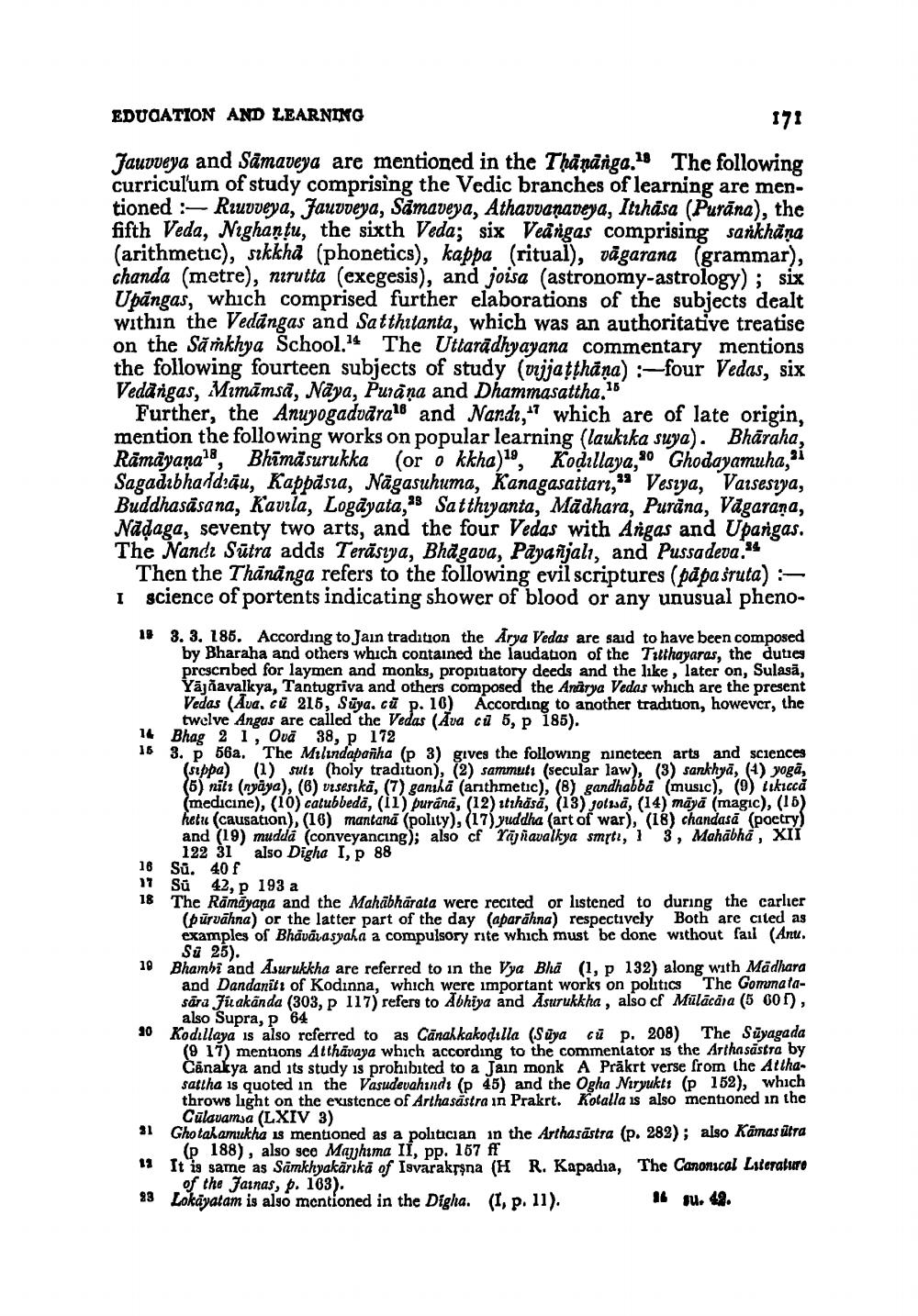________________
EDUCATION AND LEARNING
171
Fauvveya and Samaveya are mentioned in the Tharanga.18 The following curriculum of study comprising the Vedic branches of learning are mentioned: Rruvveya, Jauðveya, Samaveya, Athavvanadeya, Itihasa (Purana), the fifth Veda, Nighantu, the sixth Veda; six Veårigas comprising sankhăna (arithmetic), sikkha (phonetics), kappa (ritual), vågarana (grammar), chanda (metre), nirutta (exegesis), and joisa (astronomy-astrology); six Upāngas, which comprised further elaborations of the subjects dealt within the Vedāngas and Satthitanta, which was an authoritative treatise on the Sámkhya School.14 The Uttaradhyayana commentary mentions the following fourteen subjects of study (ujjatthāna) :-four Vedas, six Vedangas, Mimamsa, Naya, Purana and Dhammasattha.15
Further, the Anuyogadvārals and Nandı,47 which are of late origin. mention the following works on popular learning (laukika suya). Bhäraha, Rāmāyana, Bhīmāsurukka (or o kkha), Kodillaya, 90 Ghodayamuha, aí Sagadibhadd:āu, Kappasia, Nägasuhuma, Kanagasattari, 23 Vesiya, Varsesiya, Buddhasäsana, Kavila, Logayata, as Satthyanta, Madhara, Purana, Vågarana, Nadaga, seventy two arts, and the four Vedas with Arigas and Upangas. The Nandr Sūtra adds Terasiya, Bhagava, Payañjalı, and Pussa deva.94
Then the Thānanga refers to the following evil scriptures (pdpašruta) = I science of portents indicating shower of blood or any unusual pheno
18 3. 3. 285. According to Jain tradition the Arya Vedas are said to have been composed
by Bharaha and others which contained the laudation of the Titthayaras, the duties prcscribed for laymen and monks, propitiatory deeds and the like , later on, Sulasă, Yanavalkya, Tantugriva and others composed the Anarya Vedas which are the present Vedas (Ava, cu 216, Süya. cũ p. 10) According to another tradition, however, the
twelve Angas are called the Vedas (Ava cu 5, p 185). 14 Bhag 2 1, Ova 38, P 172 16 3. P 56a, The Milındapañha (p 3) gives the following nineteen arts and sciences
(sippa) (1) sutt (holy tradition), (2) sammutt secular law), (3) sankhyā, (4) yoga, (5) niti (nyaya), (6) visesika, (7) ganika (anthmetic), (8) gandhabba (music), (9) Tikicca (medicine), (10) catubbeda, (ii) purana, (12) itthāsā, (13) jotta, (14) māyā (magic), (16) hetu (causation), (16) mantana (polity), (17) yuddha (art of war), (16) chandasā (poetry) and (19) mudda (conveyancing); also cf rā navalkya smrti, 1 3, Mahābhā , XII
122 31 also Digha I, P 88 18 Sū. 40 f 17 Sû 42, p 193 a 18 The Rāmāyana and the Mahābhārata were recited or listened to during the carlier
(purvāhna) or the latter part of the day (aparāhna) respectively Both are cited as examples of Bhāvāzasyaha a compulsory rite which must be done without fail (Anu.
Si 25). 10 Bhambi and Asurukkha are referred to in the Vya Bhā (1, p 132) along with Madhara
and Dandaniti of Kodinna, which were important works on politics The Gommalasára Jilakānda (303, p 117) refers to Abhiya and Asurukkha , also cf Mülācāra (5 001),
also Supra, p 64 10 Radu.
Kodillaya is also referred to as Cānahkakodilla (Süya cū p. 208) The Süyagada
(9 17) mentions Atthāvaya which according to the commentator is the Arthasastra by Cănakya and its study is prohibited to a Jain monk A Prākrt verse from the Althasattha is quoted in the Vasudevahındı (p 45) and the Ogha Niryuktı (p 152), which throws light on the existence of Artha sästra in Prakrt. Kolalla is also mentioned in the
Cūlavamsa (LXIV 3) 31 Ghotakamukha is mentioned as a politician in the Arthasāstra (p. 282); also Kamasutra
( 188), also see Mazhıma II, pp. 167 ff 11 It is same as Samkhyakārika of Isvarakrsna (H R. Kapadia, The Canonical Literature
of the Fainas, p. 163). 23 Lokāyatam is also mentioned in the Digha. (1, p. 11).
16 u. 49.




